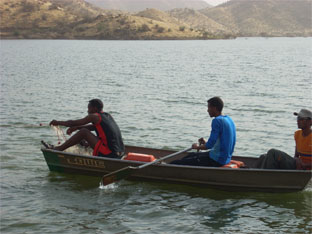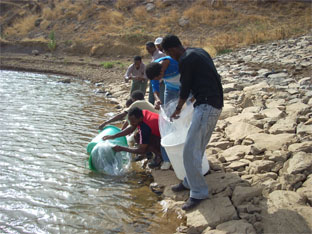From: Berhane Habtemariam (Berhane.Habtemariam@gmx.de)
Date: Mon Oct 12 2009 - 15:17:20 EDT
No More Marine Fish Only
Simon Mesfun, Oct 12, 2009
Since the old times, as there are no natural lakes in Eritrea, the people of
Eritrea have been dependent on marine fish only. But from now onwards, as
much effort is being exerted to develop freshwater fishing, the people will
have another source of fish.
Freshwater fishing takes place in lakes, ponds, rivers and streams. All the
Eritrean reservoirs are man made and rain fed with their main purpose being
for drinking water for human consumption as well as animals, irrigation for
agriculture purpose, and cooling water for electricity power plant.
http://www.shaebia.org/artman/uploads/2_109.jpg
After independence, the government of Eritrea started breeding fish in 1994
in the sources available in order to provide the community in the area with
sufficient protein and to create employment.
In developed world, fishing in lakes is largely for recreational needs;
whereas in Eritrean reservoirs, it is for food consumption and mitigating
the protein deficiency.
Mr. Seid Mohamed Abrar, Director of the Minister’s Office at the Ministry of
Fisheries, said that so far they have bred fish in 40 dams in the four
regions which do not border the Red Sea (Center, South, Gash-Barka and
Anseba). Today these freshwater fishing sources are rich in fish and can be
harvested in a large scale as soon as the needed infrastructure is
established.
Since the past few years, the Ministry has been providing short training to
the community around the reservoirs. The Ministry will also provide them
with equipment to fish. It has opened branches in all regions and these
branches are ready to provide regular training on fishing, fish preparation,
materials and extensions for fishing in 2009. “This will surely help the
community to develop the habit of eating fish,” added Mr. Seid.
In Eritrea there are four indigenous riverine freshwater species of fish:
Gara, Barbus, Cat fish and Labeo. None of the above mentioned fishes was
bred for consumption until now. In the 1940–50’s the Italians introduce the
first fishes- common-carp (Cyprinus carpio), cat-fish (Clarias gariepinus)
and Eel (Anguila anguila) mainly in the reservoirs at Elaberied Agro
Industry, Mai Ubel (Valineki) and Mai-serwa, which were built for irrigation
and drinking water purpose. The first two were well developed whereas Eel
disappeared, as it can not breed in freshwater.
http://www.shaebia.org/artman/uploads/3_079.jpg
During the colonial period, there were no recorded activities on inland
fisheries. In 1989, about 10,000 fries of Tilapia zilli and crucian carp
(Carassius carassius) were introduced by transplanting from fish rearing
centers outside the country.
After independence, in 1992, Inland Fisheries Division was formed under the
Ministry of Marine Resources and a draft of freshwater fisheries station was
prepared in 1993. Then in 1994, after conducting detailed survey in 16
reservoirs in Zoba Maekel and Zoba Debub the Ministry of Fisheries
introduced 88,500 Tilapias (Tilapia zillii and Oreochromis niloticus),
Carps-common carp (Cyprinus carpio) and crucian carp (Carassius carassius)
and gold fish (Carassius auratus) from abroad.
Mr. Dejen, from the Ministry of Fisheries said, “The survey we conducted in
1995 indicates that all the fishes introduced were well established and
started reproduction. Fish (which can be eaten) have been in the dams in
large scale since the past six years but the community couldn’t benefit from
it as they don’t have fishing equipment and knowledge.”
In 1995, physicochemical and biological studies were conducted and stocked
reservoirs were surveyed. A guide was prepared in Tigrigna to help farmers
to culture, preserve and consume freshwater fishes and Mai-Serwa was
proposed to be a research station on freshwater fishing.
More than 45 reservoirs in Zoba Maekel, Zoba Debub and Zoba Anseba were
stocked from 1994 to 1998. The reservoirs were stocked with mixed species of
fishes from the 16 reservoirs and Mai-Serwa Station.
New reservoirs in Gash Barka Region (Gerset and Fanko Zmue) were also
stocked. Two indigenous freshwater fishes were found. And Gerset reservoir
was stocked with Tilapia from Mai-Serwa.
Fish reproduces naturally. The production among the male and female fishes
in the freshwater conducts normally and the generation continues like that.
For the time being, as the community hasn’t started to fish, there is no
fear that there could be shortage of fish. Shortage could come after the
community starts fishing.
Mr. Seid said “In order to prevent the shortage, we will protect the
Juvenile (small species of fish) from being fished as they are the reason
for the continuation of these fish.”
http://www.shaebia.org/artman/uploads/4_057.jpg
The Ministry established Inland Fisheries Research Center in Mai-Sirwa in
2001 in an area of approximately 1hectar. The source of fish for the ponds
is the Mai-Serwa reservoir which has an average temperature of 20°C and a PH
of 7.6. The centre has several research and administration staff taking care
of the research operations. It is called the provider. This is one of the
major achievements of the Ministry in the past years according to a report
from it.
“We provided training on certificate level on Freshwater Fish Culture to
those who didn’t to join the College of Marine Science in 2008,” explained
Mr. Seid.
As there were no branches of the Ministry in all regions in the past years,
it had some problems in conducting its activities effectively. As the
Ministry works in collaboration with the Ministry of Agriculture and
regional administrations, things will work out well.
“We will work closely with all the actors which could play a vital role in
the development of freshwater fishing. We are strengthening our relations
and are working to establish management plan with the Ministry of
Agriculture and regional administrations as they are directly involved with
the construction and other follow-up works in the dams and other
organization like National Union of Eritrean Women (NUEW) and National Union
of Eritrean Youths and Students (NUEYS). This is because once the fishing
started, there has to be very clear administration in order to secure
existence and continuation of these fish and the fishing it self,” said Mr
Sied.
The main sources of fish according to the region they are found are in:
. Central Region – Mainefhi, Tokor, Beleza, Adi-Shaka, Mai-SIrwa and other
small dams
. Southern Region – Sememo, Harnet, Drko and other small dams
. Anseba Region - Ilaberiid and other small dams
. Gash Barka - Gerset, Farko and other small dams
http://www.shaebia.org/artman/uploads/5_039.jpg
Regarding the difference of the marine fish and freshwater fish, Mr. Dejen
said that the two fish are totally different. “You can’t just bring a fish
from the sea and put it into freshwater, it can not live there. Freshwater
is suitable for fish like Karp, Tilapia and Gold Fish. These fish have been
imported to Eritrea from different places in addition to the native Eritrean
freshwater fish Mullet, Common Carp, Cat-fish and Gara,” he added.
There is a good opportunity and ground for private businesses to invest in
the business even though it hasn’t started yet. The business in aquarium is
one of the businesses which could be exploited in the future.
There is also spot fishing which is being exercised by foreigners residing
in the country and tourists. This is for leisure only. Regarding this
activity, the Ministry is discussing with the Ministry of Tourism in order
to exercise it efficiently. This is to create some source of income for
regions by organizing permits and other fees.
Mr. Seid reminded that fishing for the purpose of food is mainly the
community’s responsibility to develop.
Our dream is to make the people of Eritrea beneficiary of the freshwater as
well as marine fish. This is by providing training, distributing pamphlets,
increasing awareness through mass media and strengthening the branches. But
it has to be known that our effort to develop the freshwater fishing is not
to replace the marine one,” stressed Mr. Seid.
For 2009, the Ministry will conduct research throughout the country in all
the reservoirs on their content through its branches. They will restock
those which need to be restocked. They will also provide training to
communities residing around 12 dams (three dams in each four regions). “We
are providing trainings to our members in the braches to develop their
capacity,” explained Mr. Seid
Regarding their future plan Mr. Seid explains saying, “Our very near future
plan is to enrich 12 sources in the above mentioned four regions and provide
the community in the area with materials and trainings. We have trained
around 120 people to involve them in the freshwater fishing work in 2009.
So, generally speaking, freshwater fishing will play a vital role in making
the food security policy successful”.
Most of the Eritrean reservoirs are situated in the highlands with an
altitude higher than 2200m. They are mainly for domestic use and irrigation.
There are 25 major reservoirs with a combined area of nearly 540 hectare,
another 200 small ones for the same purpose serving small communities or
settlements with an estimated combined area of 1500 hectares. At present
more than 46 of these reservoirs are stocked with mixed species of fish. The
number of earthen dams is increasing as the government is engaged in water
and soil conservation. All of these could be stocked with fish.
In most of the stocked reservoirs, freshwater fishes are to be caught by
enclosing in shallow bays using mosquito nets and then catching them by hand
or using hook and line for occasional consumption, and prepared fried, in
soup or in “Zignea” (Eritrean traditional food).
http://www.shaebia.org/artman/uploads/06_006.jpg
Though the market for freshwater fish does not exist, it seems that the most
acceptable fish are catfish and tilapia. Common Carp is not consumed by many
people; they find it too bony. With the aim of encouraging subsistence
fisheries, since 1998 the Ministry has been distributing hooks, lines and
gill-nets to local communities and military personnel around stocked
reservoirs. Women were trained how to prepare, preserve and market fish.
According to a report from the Ministry, currently in the world inland
fisheries accounts for 6.1% of the total global production (capture
fisheries and culture). This is in comparison with 59.8% (85 million tons)
from marine capture fisheries and 34.1% (48.4 million tons) from
aquaculture, including plants and animals. Long-term trends, from 1950 to
the present, show increases for all three categories; however, production
from marine capture fisheries has leveled off in recent years while
aquaculture has rapidly increased. In contrast, production from inland
capture fisheries has exhibited a modest, but steady increase.
© Copyright 2001-2008 Shaebia.org





----[This List to be used for Eritrea Related News Only]----